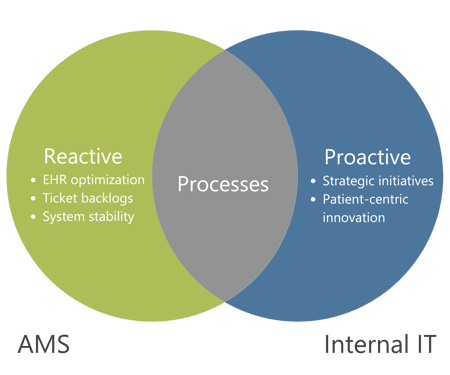 Owning a home is exciting at first. You might take pride in mowing the lawn, trimming the hedges, and even tackling small repairs; those tasks feel manageable and are rewarding. But as your life evolves — maybe your job gets busier, your family grows, or you decide to remodel your home — juggling all those previously manageable chores becomes tougher. Suddenly, what once felt simple now seems like a never-ending to-do list.
Owning a home is exciting at first. You might take pride in mowing the lawn, trimming the hedges, and even tackling small repairs; those tasks feel manageable and are rewarding. But as your life evolves — maybe your job gets busier, your family grows, or you decide to remodel your home — juggling all those previously manageable chores becomes tougher. Suddenly, what once felt simple now seems like a never-ending to-do list.
In health IT, your electronic health record (EHR) system is much like your “house.” At the start, keeping it up-to-date and user-friendly seems like something your team can handle in addition to their everyday responsibilities. Over time, though, the healthcare environment changes. New tools are introduced and priorities shift. Managing your EHR can feel like maintaining an ever-expanding home on your own — overwhelming and time-consuming — pulling your focus away from what matters most: delivering quality patient care.
Much like hiring a dedicated property manager for your digital home, this is where managed services can step in. They take care of everyday tasks, ensuring system stability, adding new features, and fixing issues before they escalate so you don’t have to do it alone. With managed services, you can keep your “home” running smoothly, no matter how your needs and priorities shift, giving you the freedom to focus on providing excellent care for patients and achieving your organizational goals.
The role of managed services in modern healthcare
Modern healthcare is shifting away from a reactive, firefighting approach toward a more strategic, proactive IT management model. Instead of scrambling to resolve break-fix issues as they arise, organizations can leverage a managed services program to offload routine maintenance tasks. This bimodal IT approach clearly divides responsibilities between two dedicated teams: one team, typically an application managed services (AMS) provider, handles the reactive tasks — such as optimizing EHR workflows, managing ticket backlogs, and ensuring system stability — while the customer’s internal IT team focuses exclusively on strategic initiatives and patient-centric innovation. By separating these responsibilities and sharing key processes like change control, both teams can operate largely independently yet come together when necessary, ensuring that the immediate operational demands do not compromise long-term strategic goals.

How a managed services model benefits everyone
- Patients: With managed services monitoring of external interfaces and work queues, patients get their results faster, reducing the administrative burden on your IT teams and improving the patient experience. Managed services can also free up your IT team to focus on patient engagement initiatives, improving the overall patient experience.
- End users: With support of common maintenance tasks like content loads or preference list updates, clinicians and support staff can easily locate their orders and simplify their tasks, improving daily workflows and overall efficiency while reducing friction with the system.
- Analysts: Managed services can automate and offload routine tickets, mapping updates or daily tasks like user and provider maintenance, freeing analysts to focus on more complex work and future-looking projects.
- Managers: With a dedicated AMS provider handling system maintenance and adhering to strict service level agreements (SLAs), managers no longer need to worry about outages, employee leave, or staffing challenges like unfilled roles and turnover. This comprehensive support frees them to focus on key operational goals, resource allocation, and strategic planning, delivering true peace of mind.
- VPs and executives: At the executive level, partnering with a managed services team delivers stability. Leaders can have confidence that IT operations are well-maintained, freeing them to focus on growth initiatives, build valuable partnerships, and encourage innovation. Insights and tailored recommendations from a strategic managed services partner further ensure that decision makers can steer the organization forward with clarity and assurance.
Core components of a managed services approach
EHR application oversight
Proactive management of EHR systems (Epic, Oracle, MEDITECH, or others) includes more than routine updates. It includes regular content loads, mapping updates, and other configuration changes. Proactively addressing potential issues minimizes disruption to end users and maintains an ongoing stable environment. Managed services aren’t exclusive to applications, however. The model can be applied to any part of IT where committed outcomes can be defined and a scope can be effectively managed.
Predictable budgeting and measurable outcomes
A robust managed services provider doesn’t just offer transparent pricing and defined SLAs — it’s willing to share risk by committing to concrete outcomes and performance targets. With structured service agreements, organizations benefit from budgeting clarity and a clear framework for accountability. This approach not only supports strategic financial planning but also demonstrates measurable success to key stakeholders, reinforcing the provider's commitment to deliver tangible, high-impact results.
Ticket monitoring and system maintenance
Consistent monitoring of routine tickets and error logs helps identify potential issues before they escalate. Early detection and resolution of these issues increases user satisfaction and reduces friction in regular workflows, which helps improve operations across the system.
Broad service portfolio
A strong managed services provider delivers a comprehensive suite of IT solutions tailored to your organization’s full range of needs. Rather than locking you into narrow contracts, these providers offer broad, flexible engagements — handling everything from interface and medication load management to routine updates of staff records and system configurations. They can even scale to function as a fully outsourced AMS team when extended support is required. By taking a holistic approach, managed services not only address immediate IT demands but also act as a strategic partner in advancing your organization’s goals.
Access to specialized expertise and talent
One of the standout advantages of a managed services partnership is access to deep, specialized talent that you may struggle to recruit internally. Rather than relying on broad industry generalists, your managed services provider brings a team of experts in EHR optimization, interface management, maintenance, and more. This ensures that you have seasoned professionals handling even the most niche areas of your IT operations — enabling you to drive better outcomes.
A forward-thinking strategy for health IT
Managed services lays the groundwork for ongoing improvement rather than one-off problem solving. With a robust, well-monitored IT environment, an organization can shift focus to patient outcomes, capital projects, and expanded service lines. This approach mirrors the direction many industries — such as finance and manufacturing — have already taken to ensure stability, scalability, and responsiveness in their operations.
Day-to-day reliability in your EHR and applications means frontline staff can work more effectively and leadership has more bandwidth for long-term strategic thinking. By embracing a managed services model, health IT leaders position their organizations to adapt quickly to emerging technologies, industry shifts, and evolving patient needs. The result is a sustainable IT strategy that fosters both immediate and long-term success.
What to look for in a managed services partner
Choosing the right managed services partner is important to achieving your organization's strategic vision. An ideal partner will:
- Go at risk for contractual commitments and won’t nickel and dime you on hours
- Proactively monitor systems and make changes to prevent issues before they arise
- Leverage the latest technologies, such as AI and automation, to improve quality, streamline processes, and gain efficiency
- Bring a forward-thinking, collaborative approach to align IT services with your organization’s strategic goals
- Exhibit deep, specialized expertise in health IT — with in-house subject matter experts in EHR optimization, interface management, transformational projects, and compliance with industry standards (e.g., ITILv4, Epic Gold Stars) — ensuring superior oversight and performance beyond broad industry generalists
- Offer scalability and flexibility to adapt as your organization’s needs evolve over time
- Serve as a true extension of your team, providing transparency, accountability, and communication
By selecting a managed services partner with these qualities, health IT leaders can ensure their investment not only delivers measurable improvements in reliability, scalability, and strategic alignment but also maximizes ROI and drives financial value. This approach is designed to achieve robust outcomes and cost efficiencies, ensuring more value for the same — or even less — investment.






